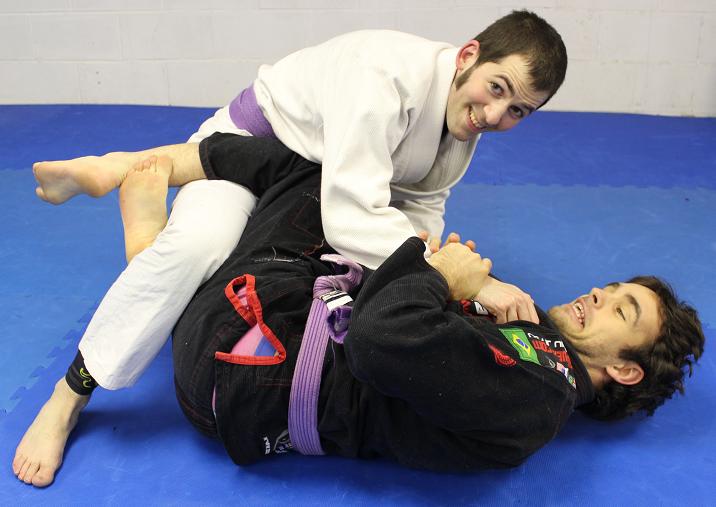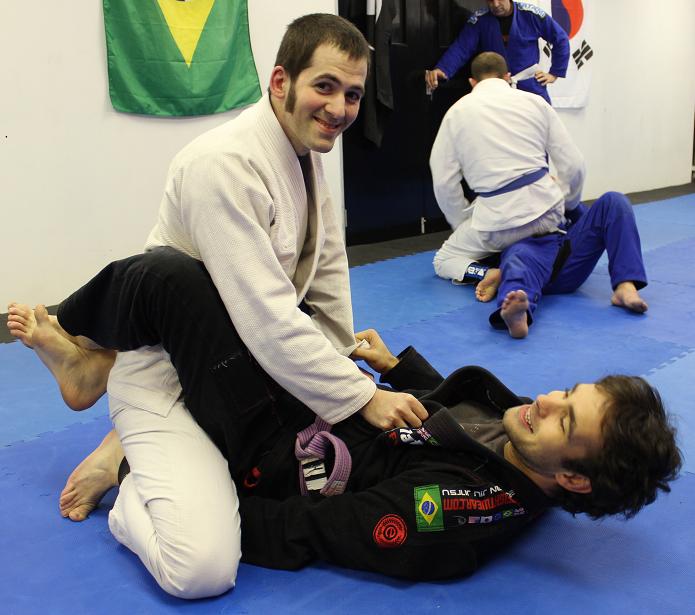Teaching #298
Artemis BJJ (PHNX Fitness), Can Sönmez, Bristol, UK - 19/03/2015
The RNC is a fundamental technique to BJJ. Everybody with more than a few lessons under their belt knows that you're going to be looking for it, so they will immediately be trying to create barriers with their arms and hands. However, as this particular class has plenty of absolute beginners, I focused on the basic application before getting into the set-up.
So, to apply a
rear naked choke (the reason for that name is that you aren't using the gi to complete the choke, hence 'naked'). Position the elbow of your choking arm under their chin. You don't want to leave any space, as the idea is to press into both sides of their neck. This will close off their carotid arteries and prevent the flow of blood to the brain. That is an efficient and safe way of subduing an opponent.

Reaching past their shoulder, you are then going to grip the bicep of your free arm. This is to lock the choke in place. It will normally be difficult to grab your bicep straight off, as your opponent knows that's dangerous. You can instead secure your initial arm by gripping the back of their shoulder. Stephan Kesting has a
useful video on RNC details, where he talks about holding the ridge of bone at the bottom of the shoulder blade, using what he calls a 'tiger palm'. From there, switch to gripping palm to palm over their shoulder, dropping the elbow of your back-arm down along their shoulder blade. That will further help to lock it in position: as
Demian Maia demonstrates, you can even finish the choke from there. If not, you can then do what Kesting calls the 'creep', wriggling that elbow across their back to cinch up the choke.
When you have managed to grip your bicep, make sure both your elbows are in front of their shoulders. In other words, your armpits are resting on their shoulders. The elbow drops straight down. As Nathan 'Levo' Leverton emphasises, this now means that both your wrists are hidden, making it difficult for them to strip your grip. It also makes the choke tighter, as both of your arms are directly by their neck.
Bring the hand of that bicep arm to the back of their head: a commonly used version is to press the palm into their skull, but there are various options, coming down to personal preference. Using the back of your hand against their neck is arguably better, as that may slip in more securely than palm down. Also, palm down is easier for them to grab, if they try to peel your fingers off their skull. Either way, when you're locking in the choke, don't reach your hand forward over their shoulder. If you do, then they can armbar you using their shoulder as a fulcrum. Instead, slide it behind the head.

Bring your head next to theirs on the bicep gripping side, to further cut off any space. If for some reason after grabbing your bicep you can't get your other hand behind their head, grab your own skull, using that grip to finish from there. Staying close to their back, expand your chest and squeeze your elbows together.
A common problem is that people will also tend to tuck their chin. Some people advocate unpleasant methods to force your way through to the neck in that situation. For example, Stephan Kesting has a list
here: the results of that kind of approach (though Kesting does make a point of saying he is not fond of pain-based options either) can be seen in
this video of a brutal Baret Yoshida match. That is not how I want my jiu jitsu to look.
My goal is smooth, technical, leverage-based jiu jitsu, causing as little pain to the other person as possible. As
Saulo says in my favourite BJJ quote:
"You have to think that your partner, the guy that you're training [with], has to be your best friend. So, you don't want to hurt him, you don't want to try to open his guard with your elbow, make him feel really pain, because jiu jitsu is not about pain. You have to find the right spot to save your energy"
I strongly feel it is best to avoid hurting your training partners, for four additional reasons:
- You're in class to learn, not to 'win' at all costs. Save the 'win' mentality for competition.
- If you're always hurting the people you spar, eventually nobody will want to train with you, making it rather hard to improve.
- Presuming you're in BJJ for the long-term, you're going to be spending a lot of time with your training partners. Therefore it would make sense to build a good relationship.
- Even if you don't care about your classmates, everybody has a different pain threshold. So, the efficacy of pain-reliant techniques will vary from person to person. The efficacy of leverage does not: that's based on physics, not how tough somebody is.
There is a less nasty option you could try for opening up their chin, from
Andre Galvao. If they really shove their chin down, this may not work, but it is worth a go. Twist your hand so that your thumb is pointing down, then as you slide the arm to their neck, twist the thumb back up to lift their chin.
If I find I have no option except something brutish (e.g., crushing their chin until they tap from pain or lift their head), my preference is to instead transition to a different attack, like an ezequiel, a bow and arrow choke or an armbar (which I'll be covering in later lessons). In my opinion, if I get to the point where force and pain are the main routes to finishing a submission, then my set up was poorly executed.
You can also try tricking them into giving you access to the hold you want, a handy tip I saw on a John Will DVD. For example, when you try to get an arm around their neck, a common reaction on their part is to grab your arm and pull it down. If you respond by pulling up, they will normally pull down even harder. This means that if you time it right, you can suddenly switch direction and swing the arm they are pulling down across your body. This should sweep their arms out of the way for a moment (try to catch both of their arms when you do this). Make sure your other hand is ready and waiting near their shoulder, as you can then immediately bring that other arm across their suddenly undefended neck.

Even better, you can take their arm right out of commission. With one of your hands, grab their wrist. Shove it down towards their legs, then step over that arm with your same side leg. When you then re-establish your hook (or pin your heel to their ribs, or put your leg behind their back), they are left with only one arm to defend against both of yours. If they've grabbed your wrist, twist your palm outwards, shove it down and out, then again step over their arm with your leg. Make sure you maintain pressure, so they can't simply swim their arm free.
There is also the method I learned
from Dónal. Grab their wrist with your armpit hand. Drop to the choking arm side, twisting your hips to increase the range of motion for your leg. Shove their arm down, then swing your leg over your armpit arm. Grip your own shin with the armpit hand, then using both your leg and arm, get your foot to their spine to trap their limb.
________________
Teaching & Sparring Notes: I went with the pattern from yesterday, combining the basic RNC application followed by swinging the arm and the thumb chin-lift. As I have that extra bit of time on Thursdays, I added in the armbar from the back. I really want to come up with something more cunning for getting the arm and the leg over the head: there must be a swisher way of doing that.
Breaking the grip for the armbar, Steve surprised me by grabbing the material on my trouser leg. You can still kick that off, but it felt a bit more awkward. I assume it is a weaker grip, as it locks my leg to them, but interesting. Then when sparring, I started without grips from the back. Steve grabbed my hands this time, making it tough to set up any kind of attack (especially as he's a powerful guy). Of course, it does mean that he couldn't do anything either. Stalemating, so is it just a matter of patience to wait for them to move?
I want to practice escapes some more, work on the on where you pull the arm over the head. On trying to apply the armbar from the back myself, Steve was able to turn and stack me. So, I messed up somewhere along in terms of keeping him flat: probably I jumped into it too early with insufficient control. I should establish a better kimura grip, as well as more effective use of my legs. It would also be worth checking Ryan Hall's DVD next time, as he had a lot of good details for back attack (Chris and I drilled a bunch of them a while back).

















